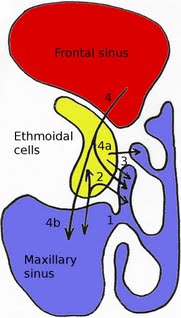Drainage system of paranasal sinus a review
Introduction:
Study of drainage system of paranasal sinuses is important in the present day context of Functional endoscopic surgery and Balloon dilatation techniques in managing sinus infections and ostial obstruction. These minimally invasive tools have thrown further light into the drainage pattern of various paranasal sinuses.
The following are the documented various racial variations:
The volume of maxillary sinus varies between races and sexes
White population has a higher incidence of concha bullosa of middle turbinate and paradoxical bending of middle turbinate when compared to that of other races
Infra orbital / suprabullar cells are commonly seen in white races
Sphenoethmoidal cells are commonly seen in chinese
Bent uncinate process and complete absence of sinuses are common in chinese
Studies have revealed extensive intercommunication between various paranasal sinuses. It can be safely construed that all paranasal sinuses in addition to their major drainage channel also contains openings connecting one with the other.
Development of nose and paranasal sinuses:
Study of embryology of nose and paranasal sinuses will go a long way in enhancing our understanding of the drainage patterns of various paranasal sinuses. The whole nasal cavity and adjoining paranasal sinuses develop from a cartilagenous anlage called the nasal capsule. This nasal capsule appears between the 7th and 8th weeks of embryonal life. The first area where this cartilage begins to develop is in the nasal septal area. The lateral nasal wall develops much later. The following are the chronology of development of lateral nasal wall:
The cartilage of inferior turbinate develops during the 8th week of gestation
Middle turbinate begins its development during the 9th week of gestation
Superior turbinate begins to develop during the 12th week of gestation.
Uncinate begins to develop during the 9th week
Ethmoidal bulla begins its development during 12th week
Anterior ethmoidal cells starts their develoment during 22nd week
Posterior ethmoid cells begin their development during 40th week
The nasal capsule has tight connections to its surroundings, especially to the cartilagenous anlage of body and minor ala of sphenoid bone. This factor helps in the normal development of sphenoid bone thus ensuring normal develpment of sphenoid sinus.
Expansion of mucous membrane forms the paranasal sinuses. The first air filled sacs in the ethmoid bone begins from the bulla ethmoidalis area. Bulla ethmoidalis gives rise to anterior and middle ethmoid air cells. Ventral to anterior ethmoidal cells the developing primordial ethmoidal infundibulum extends infero laterally towards the inferiorly placed precursor of maxillary bone. This forms the primordial maxillary sinus. At birth only the ethmoid and rudimental maxillary sinus are present. The frontal and sphenoid sinus develops after birth due to gradual pneumatization of frontal and sphenoid bones respectively.
During the process of pneumatization mucous membranes encounter each other. When this happens the underlying mesenchymal layer may disappear causing intersinus communications to form. Even though these channels of communication plays very little role in ventilation and drainage of sinuses infections can spread to other sinuses via these channels.
Drainage pathways of paranasal sinuses:
Frontal sinus: May show three types of drainage patterns.
Direct drainage via frontal recess
Drainage via ethmoido nasal route
Drainage via ethmoido maxillar route
Multiple drainage patterns are commonly seen in frontal sinus. Direct drainage is seen only in a fraction of patients. If the frontal sinus drains directly via frontal recess presence of anterior ethmoidal cells can cause obstruction to drainage of frontal sinus leading on to frontal sinus infection.
Ethmoidal cells:
These cells drain directly via upper / middle meatus.
These cells may share common drainage channel with maxillary sinus
These cells may drain via maxillary sinus
Sphenoid sinus:
Drains directly into the nasal cavity.
The following points should be borne in mind before performing Balloon sinuplasty / FESS procedures for chronic sinus infections:
Accessory sinus ostia exist for each paranasal sinuses
Many sinuses do not drain directly into the nasal cavity but indirectly drains via adjacent sinuses. For example sphenoid sinus drains both via posterior ethmoidal cells and directly into the nasopharynx.
Major drainage pathway of frontal sinus is over the ethmoidal sinus, via the ethmoids into the maxillary sinus and then into the nasal cavity
These pathways are not normally accessible during normally performed endonasal surgeries. Inadvertant manipulation can cause fractures of thin septa between these sinuses thereby impairing normal drainage patterns
Presence of secondary / accessory ostia is a definite sign of chronic sinus infection
Presence of accessory / secondary ostia ensures recirculation of mucous due to mucociliary mechanism which tends to beat towards the natural ostium
If accessory ostium is present Balloon sinuplasty invariable ends up dilating the accessory ostium instead of natural one.
It makes real sense if these drainage patterns could somehow be ascertained prior to surgical procedure instead of performing blind dilatation.

